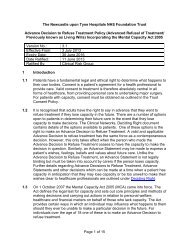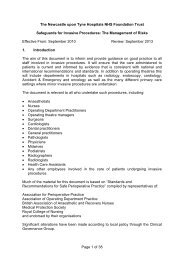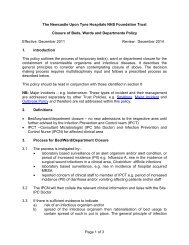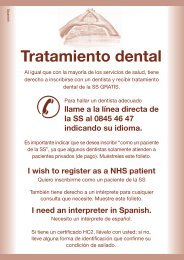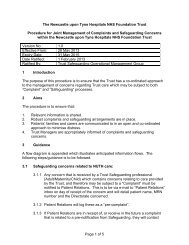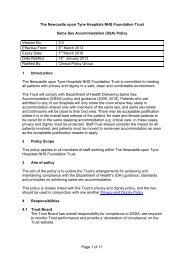(VTE) Assessment and Management - Newcastle Hospitals
(VTE) Assessment and Management - Newcastle Hospitals
(VTE) Assessment and Management - Newcastle Hospitals
You also want an ePaper? Increase the reach of your titles
YUMPU automatically turns print PDFs into web optimized ePapers that Google loves.
The <strong>Newcastle</strong> upon Tyne <strong>Hospitals</strong> NHS Foundation TrustVenous Thromboembolism (<strong>VTE</strong>) <strong>Assessment</strong> <strong>and</strong> <strong>Management</strong>Version No: 1.0Effective From: 25 April 2012Expiry Date: 30 April 2015Date Ratified:Ratified By:1. IntroductionVenous Thromboembolism (<strong>VTE</strong>) is a condition in which a blood clot (thrombus)forms in a vein, most commonly in the deep veins of the legs; this is called a deepvein thrombosis (DVT). Part of this thrombus may dislodge from its site of origin <strong>and</strong>travel in the blood to the lungs to cause a pulmonary embolus (PE). Patientsadmitted to hospital may be at increased risk of thrombosis through a combination offactors including their underlying medical condition, the treatment they are receivingfor this <strong>and</strong> the procedures being undertaken in hospital. <strong>VTE</strong> is an important causeof death in hospital patients, <strong>and</strong> treatment of non-fatal symptomatic <strong>VTE</strong> <strong>and</strong>related, long-term morbidities (chronic venous insufficiency, leg ulcers, <strong>and</strong>pulmonary hypertension) is associated with considerable cost to the health service.The risk of <strong>VTE</strong> can be reduced through the use of chemical <strong>and</strong> or mechanicalThromboprophylaxis.All adult patients admitted to hospital should have a <strong>VTE</strong> assessment that identifiesany patient <strong>and</strong> procedural risk factors for thrombosis <strong>and</strong> bleeding. This riskassessment will inform selection of the most appropriate Thromboprophylaxis takinginto account patient preferences.Within the organisation individual directorate guidelines have been developed forThromboprophylaxis <strong>and</strong> are to be used in conjunction with this policy. Patientsdeveloping symptoms during a hospital admission suggestive of <strong>VTE</strong> require furtherinvestigation <strong>and</strong> the approach to this <strong>and</strong> the management of confirmed <strong>VTE</strong> arealso covered by this policy.2. ScopeThe <strong>VTE</strong> risk assessment policy applies to all adults admitted >18years age. Thediagnostic pathways for suspected <strong>VTE</strong> <strong>and</strong> the principal of the management of <strong>VTE</strong>in adults is covered <strong>and</strong> specific treatment guidelines referenced.In children below 18 years of age, <strong>VTE</strong> are clinically very rare events, although canoccur within specific high risk groups of patients related to specific therapies orunderlying conditions. <strong>Assessment</strong> of children at high risk of <strong>VTE</strong> <strong>and</strong> themanagement of confirmed thrombosis is covered in the paediatric directorate specificguidelines. The policy will outline the verbal <strong>and</strong> written information available forpatients / carers which provide education on the signs <strong>and</strong> symptoms of <strong>VTE</strong>,Thromboprophylaxis <strong>and</strong> management of <strong>VTE</strong> to allow patient involvement in theprocess.Page 1 of 7
3. Aims <strong>and</strong> objectivesThe aim of this policy is to outline the process used within the Trust for the <strong>VTE</strong> riskassessment of different patient groups using the e-record electronic assessment tool<strong>and</strong> the provision of appropriate Thromboprophylaxis for patients identified atincreased risk. The objective is to reduce the number of patients developing <strong>VTE</strong>during their hospital stay <strong>and</strong> in the 90 days following discharge.The pathways for the investigation of both patients referred for the exclusion of <strong>VTE</strong><strong>and</strong> existing in-patients with suspected <strong>VTE</strong> <strong>and</strong> the management of confirmed <strong>VTE</strong>are outlined with reference to specific Directorate <strong>and</strong> Trust guidelines for detailedprescribing information.4. Process/ risk assessment for identifying patients at risk of venousThromboembolism4.1 All adult patients admitted to <strong>Newcastle</strong> upon Tyne <strong>Hospitals</strong> NHS Trust musthave a <strong>VTE</strong> & bleeding risk assessment which is to be completed using the e-record document. (Link 1: guidance on completing e-record <strong>VTE</strong>assessment). Specific <strong>VTE</strong> assessment forms are available for admissions inthe following clinical areas: Antenatal, postnatal, trauma, plastic surgery <strong>and</strong>neurosurgery. For all other adult admissions Paediatric assessment forchildren
4.6 The need for extended Thromboprophylaxis must be considered in certaincases including following total hip & knee replacement, fractured neck offemur, patients in lower limb casts, <strong>and</strong> abdominal/ pelvic surgery for cancer<strong>and</strong> day surgery patients who are likely to have prolonged immobility ondischarge. Thromboprophylaxis should continue until the patient is fully mobileor for the defined periods recommended by NICE for the patient groupsdescribed above. (Link NICE Clinical Guidelines 92).Patients being discharged on extended Thromboprophylaxis should have thisdocumented in the discharge summary <strong>and</strong> the patient or their carer shouldbe given verbal <strong>and</strong> offered written information on this. (Link 3 patientinformation on extended Thromboprophylaxis)4.7 All patients should be adequately hydrated unless there is a clinical reasonnot to do this. Patient should be mobilised as early as possible. Patientsshould be shown how to exercise their legs if they are on bed rest to preventstasis developing in the deep veins in the leg.4.8 Reassessment of a patient’s <strong>VTE</strong> risk <strong>and</strong> their Thromboprophylaxis regimeshould be undertaken within 24 hours of admission <strong>and</strong> whenever there is anysignificant change in the patient’s underlying condition/ treatment. This shouldbe documented by opening the previous <strong>VTE</strong> assessment form on e-record<strong>and</strong> either documenting the change in bleeding or thrombotic risk orconfirming no change. Changes in the clinical risk/benefit assessment thatlead to alteration in the Thromboprophylaxis regime should be documented inthe clinical notes. Reassessment should ensure the methods of <strong>VTE</strong>prophylaxis being used are suitable <strong>and</strong> are being used correctly. If anyadverse events resulting from <strong>VTE</strong> prophylaxis are identified these should bedocumented in the patient’s notes <strong>and</strong> reported to the directorate clinicalgovernance / mortality <strong>and</strong> morbidity meeting.5. Patient information5.1 Written information of <strong>VTE</strong> prevention has been incorporated into the newTrust pre-operative information pack sent to all patients admitted for electivesurgical procedures. Verbal information will be given to patients requiringemergency admission after risk assessment has been undertaken.5.2 Patients/carers will be offered verbal <strong>and</strong> written information on <strong>VTE</strong>prevention <strong>and</strong> the recognition of symptoms that should lead to furtherassessment for a <strong>VTE</strong> as part of the discharge processes. (Link 4: patientinformation leaflets signs <strong>and</strong> symptoms <strong>VTE</strong>).5.3 Patients discharged on extended Thromboprophylaxis should be given verbalinformation on the intended duration <strong>and</strong> offered written information onpotential side effects <strong>and</strong> symptoms that could represent a <strong>VTE</strong> <strong>and</strong> the needto report these. This information should be included in the dischargesummary.Page 3 of 7
6. Prophylactic treatment regime for high risk patients6.1 Patients assessed to be at risk of <strong>VTE</strong> must be offered <strong>VTE</strong> prophylaxis. TheDirectorate specific guidelines on Thromboprophylaxis identify specificprocedure/ patient related factors that may influence the bleeding/ thromboticrisk should be referred to for specific prescribing information. The Directoratespecific guidelines will be accessible through the intranet <strong>VTE</strong> site in additionto each Directorate’s guideline site. All Directorate specific guidelines must besubmitted to the Trust Thrombosis Committee for approval <strong>and</strong> confirmationthat they are compliant with advice in NICE clinical guideline 92.6.2 In patients with renal impairment (eGFR
as outpatient, Link 7 Tinzaparin prescribing guidelines, Link 8 Guidelines onthe initiation of warfarin). Patients should be offered an outpatient clinicreview appointment with either the Thrombosis team or the attendingphysician at 4-6 weeks.8.2 Patients confirmed to have a pulmonary embolus will be commenced ontherapeutic LMWH <strong>and</strong> commenced on warfarin (Link 7 Tinzaparin prescribingguidelines, Link 8 Guidelines on the initiation of warfarin). Patients will beassessed for early discharge <strong>and</strong> outpatient management. All patients shouldbe referred to the Thrombosis team for outpatient clinic review unless theadmitting Consultant physician team wishes to provide this at 4-6 weeks.8.3 In-patients developing symptoms confirmed on further investigation torepresent a <strong>VTE</strong> will be managed following the Trust therapeutic LMWH <strong>and</strong>warfarin guidance. Advice may be sought from the on-call Haematologist foradvice on any management concerns. On discharge referral to theThrombosis team for an out patient clinic review should be made <strong>and</strong> referralto the anticoagulation service for monitoring of warfarin (Link 9 Trust referralform for anticoagulation monitoring).9. Staff training9.1 All clinical staff (medical <strong>and</strong> nursing) will complete the Breeze presentationon <strong>VTE</strong> prevention every 3 years. A record of the training will be maintained intheir electronic training portfolio. Foundation doctors are all required tocomplete the BMJ e-module on anticoagulation <strong>and</strong> evidence of this isconsidered as m<strong>and</strong>atory for a successful ARCP outcome.9.2 Staff involved in the assessment <strong>and</strong> fitting of anti-embolism stockings musthave completed training on this. Each clinical ward will nominate a lead nursewho will attend a training session <strong>and</strong> cascade the training to other wardbased staff. A register of training will be maintained by the trainingdepartment.10. Equality <strong>and</strong> diversityThe Trust is committed to ensuring that, as far as is reasonably practicable, the waywe provide services to the public <strong>and</strong> the way we treat our staff reflects theirindividual needs <strong>and</strong> does not discriminate against individuals or groups on anygrounds. This document has been appropriately assessed.11. Monitoring11.1 Monitoring of the completion of risk assessment of patients for <strong>VTE</strong> will beperformed by the informatics after coding of patient episodes. The monthlyfigures are devolved to the individual directorates <strong>and</strong> the Chair of theThrombosis Committee. Any Directorate not achieving 90% assessment ofadmissions will be provided with a further ward based breakdown of data toassist investigation of the problem <strong>and</strong> development of an action plan.Support with this will be available from the clinical informatics <strong>and</strong> clinicalPage 5 of 7
effectiveness team <strong>and</strong> thrombosis committee members. The implementationof appropriate Thromboprophylaxis will be reviewed by point prevalenceaudits within each directorate every month.11.2 All new <strong>VTE</strong> events diagnosed in hospital in-patients will be reported onDatix by the ward nursing staff. An alert of the incident will be sent to theanticoagulation nurse specialists <strong>and</strong> chair of the Thrombosis committee.Hospital acquired <strong>VTE</strong> (HAT; defined as a <strong>VTE</strong> occurring during a hospitaladmission or within 90 days of a hospital admission) require further root causeanalysis to identify whether the thrombosis was avoidable <strong>and</strong> if so identifychanges in practice with regard to <strong>VTE</strong> prevention .An electronic investigation report will be sent for completion to the consultantclinician responsible for in-patient admission episode in which the <strong>VTE</strong>occurred. The completed form will be returned within 2 weeks <strong>and</strong> copies willbe sent to the Chair of the Thrombosis committee <strong>and</strong> the appropriate clinicaldirectorate representative on the thrombosis committee. If an area ofThromboprophylaxis assessment or prescribing is identified to havecontributed to the <strong>VTE</strong> an action plan with a timescale of implementation willbe indicated on the form. All <strong>VTE</strong> events occurring during an inpatientadmission (HAT) will be reviewed in existing directorate morbidity <strong>and</strong>mortality / clinical governance meetings.11.3 Patients presenting with symptoms of acute <strong>VTE</strong> will have their admissionhistory in the preceding 90 days reviewed by one of the anticoagulant nursespecialists when their referral to the thrombosis service, for either initiation ofwarfarin or outpatient clinic review, is received. If any hospital admissions areidentified an investigation of the index admission prior to presentation will beundertaken by one of the anticoagulant nurse specialists <strong>and</strong> an electronicinvestigation report completed. The report will be sent to the Chair of theThrombosis committee <strong>and</strong> the appropriate clinical directorate representativeon the thrombosis committee. If the investigation report identifies a possibleavoidable event the chair of the thrombosis committee will contact theconsultant involved in the index admission for comment <strong>and</strong> identification ofany action points <strong>and</strong> the timescale of implementation. The report will bereturned to the Chair of the Thrombosis committee within 2 weeks.11.4 A summary of HAT’s will be reported to the clinical governance <strong>and</strong> qualitymeeting by the chair of the thrombosis committee. The thrombosis committeemeets four monthly <strong>and</strong> will review the RCA reports of hospital acquiredthrombosis <strong>and</strong> provide leadership in developing <strong>and</strong> implementing the <strong>VTE</strong>prevention <strong>and</strong> management guidelines as new evidence <strong>and</strong> nationalguidance emerges.St<strong>and</strong>ard/process/issue Monitoring <strong>and</strong> auditBy Committee FrequencyReview of HAT <strong>and</strong> RCA Chair of the ClinicalTwo monthly<strong>and</strong> compliance CQUIN ThrombosisCommitteeGovernance <strong>and</strong>Quality CommitteeImplementation <strong>and</strong> Chair of the Thrombosis 4 monthlyPage 6 of 7
development of actionplans to reduce HAT <strong>and</strong>audit data on <strong>VTE</strong>prevention <strong>and</strong>managementCompliance with CQUIN<strong>VTE</strong> assessment <strong>and</strong>provision ofThromboprophylaxisImplementation of <strong>VTE</strong>prophylaxis <strong>and</strong>procedure for suspected<strong>VTE</strong>ThrombosisCommitteeDirectoratePharmacy/clinicaleffectivenessaudit teamCommitteeDirectorate clinicalgovernancemeetingThrombosisCommitteeMonthly4 MonthlyPage 7 of 7


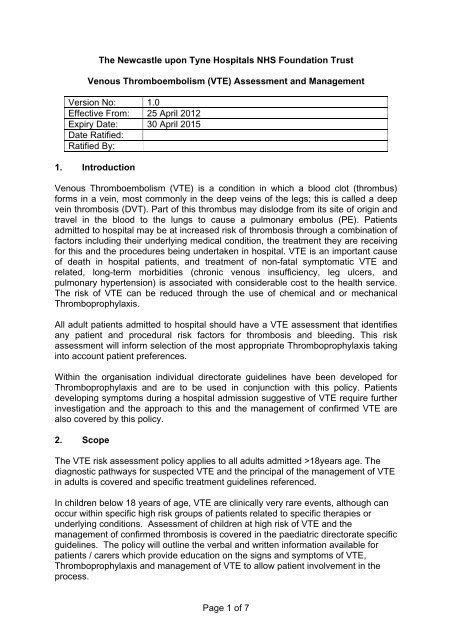
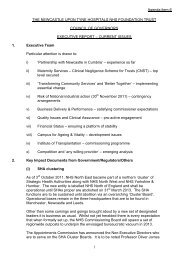
![Standard Precautions Policy - 112KB [PDF] - Newcastle Hospitals](https://img.yumpu.com/51150129/1/184x260/standard-precautions-policy-112kb-pdf-newcastle-hospitals.jpg?quality=85)
![Oxygen Management Policy - 38KB [PDF] - Newcastle Hospitals](https://img.yumpu.com/50798872/1/184x260/oxygen-management-policy-38kb-pdf-newcastle-hospitals.jpg?quality=85)
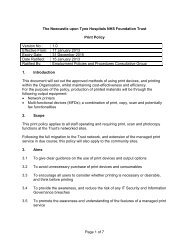
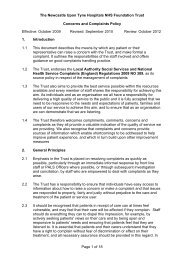
![Patient Identification Policy - 130KB [PDF] - Newcastle Hospitals](https://img.yumpu.com/49156101/1/190x245/patient-identification-policy-130kb-pdf-newcastle-hospitals.jpg?quality=85)
